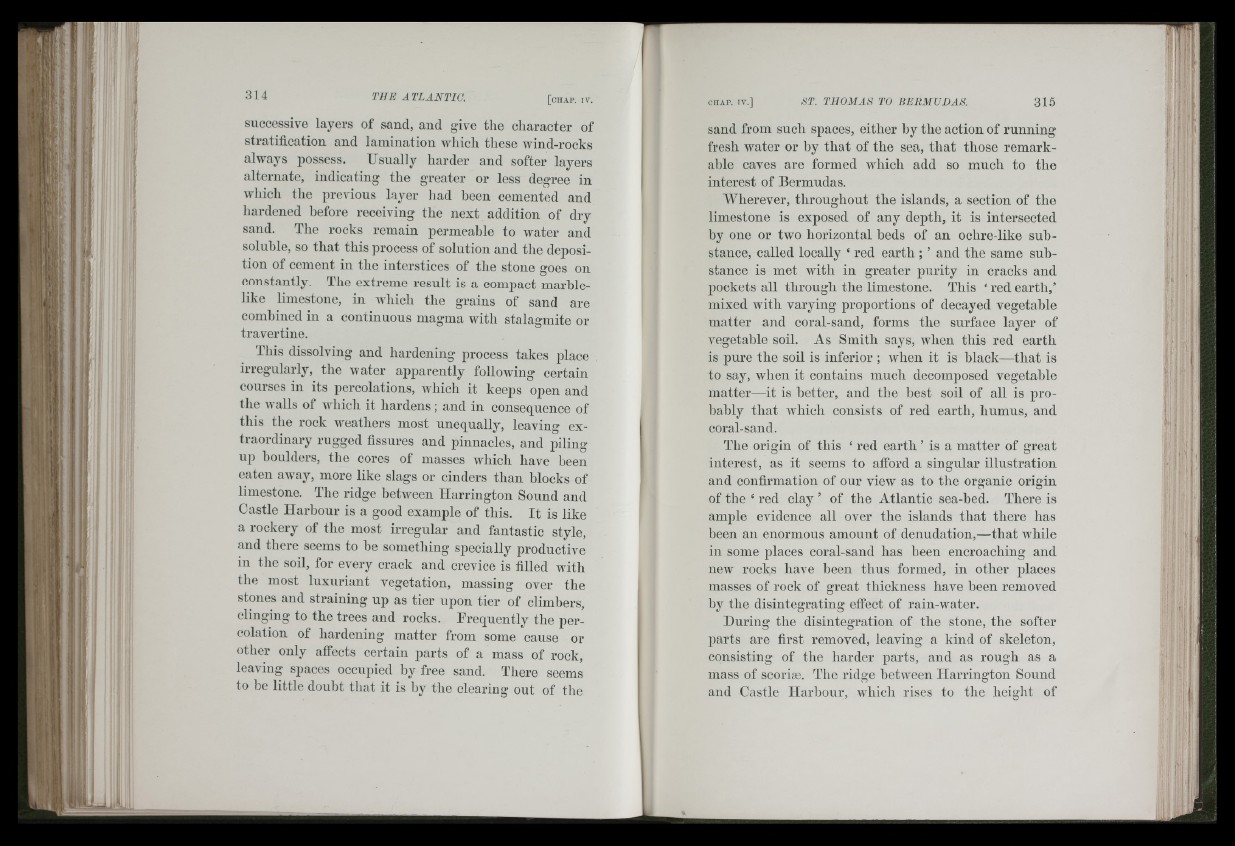
Pii
T il
il
ill
successive layers of sand, and give the character of
stratification and lamination which these wind-rocks
always possess. Usually harder and softer layers
alternate, indicating the greater or less degree in
which the previous layer liad been cemented and
hardened before receiving the next addition of dry
sand. The rocks remain permeable to water and
soluble, so that this process of solution and the deposition
of cement in the interstices of the stone goes on
constantly. The extreme result is a compact marblelike
limestone, in which the grains of sand are
combined in a continuous magma with stalagmite or
travertine.
This dissolving and hardening process takes place
irregularly, the water apparently following certain
courses in its percolations, which it keeps open and
the Avails of Avhich it hardens; and in consequence of
this the rock Aveathers most unequally, leaving extraordinary
rugged fissures and pinnacles, and piling
up boulders, the cores of masses which have been
eaten aAvay, more like slags or cinders than blocks of
limestone. The ridge betAA'een Harrington Sound and
Castle Harbour is a good example of this. It is like
a rockery of the most irregular and fantastic style,
and there seems to he sometliing specially productive
in the soil, for every crack and crevice is filled Avith
the most luxuriant vegetation, massing over the
stones and straining up as tier upon tier of climbers,
clinging to the trees and rocks. Erequently the percolation
of hardening matter from some cause or
other only affects certain parts of a mass of rock,
leaving spaces occupied by free sand. There seems
to be little doubt that it is by the clearing out of tlie
sand from such spaces, either by the action of running
fresh water or by that of the sea, that those remarkable
caves are formed which add so much to the
interest of Bermudas.
Wherever, throughout the islands, a section of the
limestone is exposed of any depth, it is intersected
by one or two horizontal beds of an ochre-like substance,
called locally ‘ red earth ; ’ and the same substance
is met Avith in greater purity in cracks and
pockets all through the limestone. This ‘ red earth,’
mixed with varying proportions of decayed vegetable
matter and coral-sand, forms the surface layer of
vegetable soil. As Smith says, when this red earth
is pure the soil is inferior ; when it is black—that is
to say, Avhen it contains much decomposed vegetable
matter—it is better, and the best soil of all is probably
that AA'hich consists of red earth, humus, and
coral-sand.
The origin of this ‘ red earth ’ is a matter of great
interest, as it seems to afford a singular illustration
and confirmation of our view as to the organic origin
of the ‘ red clay ’ of the Atlantic sea-bed. There is
ample evidence all over the islands that there has
been an enormous amount of denudation,—that while
in some places coral-sand has heen encroaching and
new rocks have heen thus formed, in other places
masses of rock of great thickness have been removed
by the disintegrating effect of rain-water.
During the disintegration of the stone, the softer
parts are first removed, leaving a kind of skeleton,
consisting of the harder parts, and as rough as a
mass of scoriæ. The ridge between Harrington Sound
and Castle Harbour, which rises to the height of
si I
ill' ^ .P ! li : r , •
d ■ j
I!!’*' I, iiiiij ((■ '
iiih'
A I
liii'I; h ih
111 III ! : i ' I